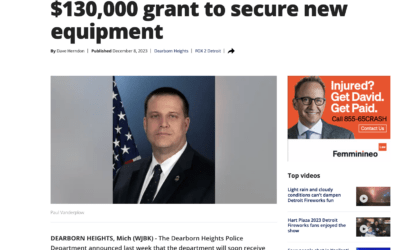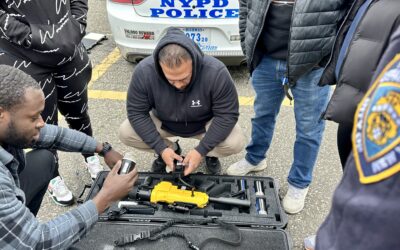EVERETT — Rob Beidler grows solemn recalling that afternoon two years ago when he first heard the mother describe her loss.
Kim Schlau spoke of waiting for her two teenage daughters to arrive home. They were late. Her eldest didn’t answer her phone.
The hours ticked by. The worried woman was heading out to go looking when grim-faced visitors arrived at her door.
Uniforms. A chaplain. She recognized the coroner. Her girls had been killed in a terrible crash.
The person responsible? An Illinois state trooper who had been driving 126 mph to another accident. An investigation determined he’d already been waved off the call and was using his cellphone when he lost control of his patrol vehicle and smashed into oncoming traffic.
Beidler, who serves as undersheriff in Snohomish County, heard Schlau speak in 2015 while he was attending the FBI National Academy’s program for law enforcement leaders. The 10 weeks of classes and lectures aim to showcase the latest ideas for those who manage the day-to-day challenges of policing across the country.
Schlau’s talk was part of a presentation on Below 100, a program that encourages law officers to take a clear-eyed look at the risks posed for themselves and others when they get behind the wheel of emergency vehicles.
In 2016, traffic fatalities were second only to gun violence in claiming police officers’ lives around the U.S. A study of line-of-duty deaths between 2010 and 2014 found nearly 40 percent happened in crashes.
Add to that the people harmed when police chases go terribly wrong or, as happened to Schalu’s family, the tragedies that can unfold when an officer ignores risks while driving.
Beidler said his first phone call that afternoon was to his boss, Sheriff Ty Trenary. He proposed making safer driving a top priority for the county’s 270 commissioned sheriff’s deputies as well as its corrections officers and civilian employees.
“I’m in,” he remembers Trenary telling him.
Two years later, the sheriff’s office has seen a marked decline in traffic accidents and injuries, as well as a reduction in high-risk police chases. There are new policies, including review boards that treat accidents and chases with the same gravity once reserved for use-of-force incidents. The department also has outfitted its vehicles with technology it is using to reinforce good driving habits and to identify training issues.
Twice in recent months, those efforts have brought Snohomish County national honors.
Deputies in Washington’s third most-populous county have a new imperative when it comes to patrolling the community’s urban streets and country roads.
“We want to get our people home,” Beidler said recently — not only those in uniform, but the folks they’ve sworn to protect and serve.
Risky business
Police have long understood that driving is one of the riskiest aspects of their jobs. And when things go wrong, the result can be devastating.
For the sheriff’s office, one awful example came in April 2015, when deputy John Sadro was speeding down an Everett street while transporting a witness to court. He ran a stop sign, broadsided another vehicle and slammed into a construction worker’s pickup truck. That man was working outside his rig. He lost his legs after being pinned between the truck and a parked car. The county settled civil claims for $14.3 million. Sadro pleaded guilty earlier this year to reckless driving and reckless endangerment, gross misdemeanors.
Over the years, some of the worst police crashes have happened during pursuits. In 2010, for example, deputies chased a driver into Everett. Multiple police vehicles smashed into each other, including one driven by a deputy that went airborne as he crested a sharp rise in the roadway. An Everett officer was seriously injured.
One of Trenary’s first public steps to improve driving safety was to implement a new pursuit policy for the sheriff’s office.
As part of the roll out, he asked Schlau to come speak with his departments supervisors. A video of her talk has since become required viewing for all deputies.
The new pursuit rules make clear that sheriff’s supervisors are responsible for calling the shots during chases, and they have more authority to swiftly bring things to a halt. That’s particularly true if deputies know the identity of the fleeing person. Deputies no longer chase if the suspect is wanted for misdemeanors, except for DUI. And when a supervisor terminates a pursuit, that doesn’t mean following at lower speed, without lights and sirens. Instead, deputies are required to pull over and stop.
Chases were down by about one third in 2016 and the trend has held in 2017. The reasons for pursuits also appears to be changing. During the first quarter of this year, most of the chases involved drunken driving suspects; last year it was stolen vehicles. In 2010, the majority of chases focused on people wanted for misdemeanors and traffic infractions, the data show.
When deputies do engage in pursuits, they now know their decisions will be subject to examination by a review board made up of their peers.
The board provides a consistent, objective way of examining what happened to determine if policies have been followed, Beidler said. It’s also an opportunity to highlight what has gone right.
Trenary acknowledged the changes were met with some skepticism. Chasing less doesn’t mean letting more bad guys go. Instead, less-risky means are employed to track down those who think they can outrun consequences.
“We don’t just walk away,” the sheriff said.
Hearts and minds
Deputies also are being encouraged to think differently about their driving. Key to that effort are the five tenets of the Below 100 program. Through posters on precinct walls, screen savers on data terminals and mobile apps, sheriff’s office employees are regularly encouraged to wear their seat belts; to don their body armor (which also protects during crashes); to watch their speed; and to avoid distractions and complacency when it comes to safety.
Deputy Mike Vafeados has spent more than 17 years with the sheriff’s office, most of that time working from a patrol car. His duties now include helping train others about traffic safety, including new recruits attending the state’s law-and-justice academy.
He’s a big believer in data, or as he puts it, “intelligence-based decision making.”
Take seat belt use. Some cops opt not to buckle up, reasoning seat belts slow their ability to exit patrol vehicles, perhaps costing them a few seconds when lives are at stake. But Below 100 proponents point to crash data, and the injuries sustained by unrestrained officers, to demonstrate that the laws of physics apply to everybody.
The same is true about racing to the next call, regardless of traffic and weather conditions. Unless there is an emergency, that happens “for no good reason, really, just because we can,” Vafeados said.
Source: http://www.heraldnet.com/news/snohomish-county-sheriffs-office-in-pursuit-of-safety/



